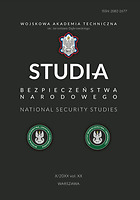THE APPLICABILITY OF THE GDPR TO ARTIFICIAL INTELLIGENCE AND THE RESULTING THREATS TO NATIONAL INFORMATION SECURITY
THE APPLICABILITY OF THE GDPR TO ARTIFICIAL INTELLIGENCE AND THE RESULTING THREATS TO NATIONAL INFORMATION SECURITY
Author(s): Tomasz GutaSubject(s): Security and defense, ICT Information and Communications Technologies
Published by: Wojskowa Akademia Techniczna im. Jarosława Dąbrowskiego
Keywords: GDPR; A.I.; Artificial Intelligence; national security; information security; data privacy;
Summary/Abstract: Both national security and information security are closely associated with and connected to the emerging field of artificial intelligence. In this regard, following the presumed axioms of the anticipated proliferation of AI systems within modern society and its expected widespread implementation in vital public and private institutions and furthermore the extensive application of AI systems within personal data processing, possible threats to national and information security within the European Union - with an emphasis on Poland and the Polish legal system – are explored. On the basis of an overview of the theoretical basis of the concepts of national and information security and artificial intelligence, the emergence of AI within personal data processing in the context of the GDPR legal framework is discussed. At least one potential conflict between the implications of the hypothetical scenario of the emergence of the so-called strong form of artificial intelligence and both the Polish data privacy legal framework (based, inter alia, on the GDPR) and the Polish information security is being identified in this context. The academic article draws the conclusion that the emergence of so-called “strong AI” may lead to a number of real and probable threats to the system of personal data protection and information security in Poland (and possibly in other EU Member States as well). The paper finally concludes by outlining and discussing the negative impact of the identified conflict, in particular on Polish information security, and calls for efforts to address these issues in future studies in the academic literature.STOSOWANIE RODO W ZAKRESIE SZTUCZNEJ INTELIGENCJI I WYNIKAJĄCE Z TEGO ZAGROŻENIA DLA BEZPIECZEŃSTWA INFORMACYJNEGO PAŃSTWABoth national security and information security are closely associated with and connected to the emerging field of artificial intelligence. In this regard, following the presumed axioms of the anticipated proliferation of AI systems within modern society and its expected widespread implementation in vital public and private institutions and furthermore the extensive application of AI systems within personal data processing, possible threats to national and information security within the European Union - with an emphasis on Poland and the Polish legal system – are explored. On the basis of an overview of the theoretical basis of the concepts of national and information security and artificial intelligence, the emergence of AI within personal data processing in the context of the GDPR legal framework is discussed. At least one potential conflict between the implications of the hypothetical scenario of the emergence of the so-called strong form of artificial intelligence and both the Polish data privacy legal framework (based, inter alia, on the GDPR) and the Polish information security is being identified in this context. The academic article draws the conclusion that the emergence of so-called “strong AI” may lead to a number of real and probable threats to the system of personal data protection and information security in Poland (and possibly in other EU Member States as well). The paper finally concludes by outlining and discussing the negative impact of the identified conflict, in particular on Polish information security, and calls for efforts to address these issues in future studies in the academic literature.
Journal: Studia Bezpieczeństwa Narodowego
- Issue Year: 24/2022
- Issue No: 2
- Page Range: 25-46
- Page Count: 22
- Language: English

